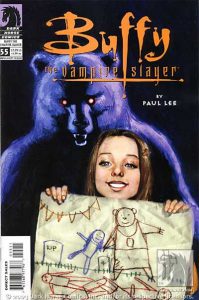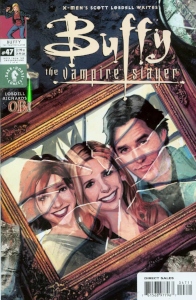“X-Men” veteran Scott Lobdell and “Deadpool” co-creator Fabian Nicieza become the third and final regular helmer(s) on “Buffy Classic,” following Andi Watson, who did uneven work while being handcuffed by continuity, and Tom Fassbender and Jim Pascoe, who found ways to tell creative stories on the comic pages. Out of the gates, Lobdell and Nicieza (who had previously written “The Death of Buffy: Lost and Found”) impressively raise Fassbender/Pascoe’s already high bar.
“Note from the Underground” (Issues 47-50, August-October 2002)
The new writers – with the art team of Cliff Richards (pencils), Will Conrad (inks) and Dave McCaig (colors) still on hand — wisely tap into the open territory in the summer after Season 6. That means there’s no Willow, Giles or Spike, but that’s a good thing, as we get to see the dynamic of Xander, Dawn and Anya, who are trapped in an underground fighting ring in the old Initiative HQ, waiting for Buffy to save them. In fact, it makes me wish we saw some episodes with just these four, as Willow and Spike tend to steal the thunder.
We’ve seen underground fighting rings before, in the “The Ring” (“Angel” 1.16), the “Buffy”/“Angel” Wizard No. ½ issue and Nancy Holder’s overloaded book “The Evil That Men Do.” But the redundancy isn’t a problem for me, as I love the fact that Lobdell and Nicieza fill most of the first issue with the “Angel” gang. (While it takes place after “Buffy” Season 6, “Angel” Season 3 has not yet concluded at this point.) Cordy’s vision of Buffy in trouble at the hands of the Scourge (Doyle’s nemeses from Season 1) brings Angel to Sunnydale – along with Faith (yay!).
It’s fan service, yes, but it’s in service to a strong narrative and character arcs. I like how Faith observes Buffy and Angel continuing to help the helpless, and questions whether she is doing the right thing by staying in prison (aside from her little free passes; in this case, Angel calls in a favor with a high-ranking official to get Faith sprung).
Adam pops up as a virtual (and he thinks indestructible) being, and he gets a better send-off than in Season 4. Buffy defeats him not with her physical skills but by outsmarting his predictions. Adam is focused on what a Slayer would do and she behaves as Buffy would do. Buffy is very much the Big Damn Hero you might expect from an “X-Men” writer.
The return of Pike is a bit more like fan service, as there isn’t a solid reason why he pays Buffy a visit — unlike in Christopher Golden’s Season 3 novel “Sins of the Father,” where he needs Buffy’s help to get a demon off his back. I like the scene where Buffy feels the presence of Spike in his old Initiative cell, and Pike thinks Buffy has muttered his name; it’s a nice way to acknowledge the oddity of two “Buffy” characters having similar names.

Issue 50 also features a bonus prose story by Nicieza called “The First Time,” in which Buffy tells Dawn about the first vampire she staked. The yarn nicely ties in with “The Origin,” showing us Buffy’s inner conflict of whether to view vampires as monsters or as the people (indeed, often classmates) they once were.
5 stars

“Viva Las Buffy!” (Issues 51-54, November 2002-February 2003)
“Viva Las Buffy!” finally fills in the long-teased story gap of Buffy and Pike’s adventure in Las Vegas. The 1992 movie ends with the duo in Vegas, and in “The Origin” – which conforms Joss Whedon’s movie script to the TV timeline and lore – Christopher Golden retains that teaser. Then in “Sins of the Father” (pages 35-36), Buffy tells Angel a bit about her time with Pike in Vegas.
For some reason, when Lobdell and Nicieza tackle this yarn, they contradict Golden’s prose. Some of it is minor, like Buffy finding a casino token that leads her to Vegas, rather than hearing about vampire-style killings on the news. But it’s jarring that in “Sins of the Father,” Buffy says Pike fell under a demon’s thrall and she had to hurt him, thus resulting in the scar above his eye. That’s not in the comic.
And it arguably should’ve been. At the end of Issue 50, as Pike begins to tell the Vegas tale to the Scoobies, Buffy begs him not to. Giving Pike a scar, and blaming herself for letting him get possessed by the demon, might’ve explained her embarrassment. Or perhaps the tale might’ve contained embarrassments resulting from two 15-year-olds having access to free booze – which would be a cliché, but it would make sense.
But then we see the actual story, and Buffy acquits herself amazingly well. This is her second major Slaying mission and she has no Watcher to guide her. But her solution of dunking a priest into the hotel’s water supply then turning on the fire sprinklers to kill the vamps with holy water ranks among her greatest hits.
Perhaps Buffy’s embarrassment comes from her skimpy coat-check girl outfit. She and Pike have gotten jobs at the Golden Touch casino in order to investigate the vampire activity within. But that doesn’t totally jibe, since it’s just a verbal retelling by Pike; it’s not like he pulls out photographs.
Lobdell and Nicieza again make up for the lack of an “Angel” comic at this point in time by giving a significant cameo to Angel, who watches Buffy from afar and gets caught up in a side battle against the evil casino owners. This adds an interesting wrinkle to their conversation in “Sins of the Father,” as we now realize Angel passed on an opportunity to tell Buffy he was present during that adventure (probably not wanting to seem like a stalker).
“Viva Las Buffy!’s” biggest strength is how it fleshes out Pike’s character. He narrates the proceedings, and we see how he is torn between wanting to help Buffy and wanting to leave. He can see that she always has one eye on him, worrying about his safety. This is a warmer insight into his character than we get in “Sins of the Father,” where he says he didn’t want to commit to fighting evil – although both interpretations are very human, especially for a teenager. Pike is not a larger-than-life hero, which makes him a refreshing contrast even from, say, Xander or Doyle, whose arcs ultimately carry them toward heroism.
In one insane scene, though, Pike tries to commit suicide by jumping off a roof, as a way to remove himself from the equation so Buffy can focus on slaying. This would’ve actually been a perfect place to show he is under a demon’s thrall, but the comic gives no hint of this.
Still, “Viva Las Buffy!” is a moving tale of Pike’s unrequited love for Buffy, and we can understand why he would leave despite caring deeply for her. Buffy, for her part, doesn’t come off badly, since we see she is getting a feel for her Slayer side during this time and is understandably focused on that rather than romance.
This arc promises more than it delivers – failing to address Buffy’s desire that her friends not hear this tale and failing to tidily link up with “Sins of the Father.” But examined independently of its baggage, it’s an excellent character piece for Pike, Buffy, Angel and even Giles (a side story shows how the Watchers’ Council chooses to assign him to Buffy). All told, I’m glad that what happened in Vegas didn’t stay in Vegas.
4 stars

“Dawn and Hoopy the Bear” (Issue 55, March 2003)
This is perhaps overly geeky (then again, that’s what this blog is about, I suppose), but I have to talk about Dawn being in comic stories before she exists. In “False Memories,” it’s no problem, since we’re seeing the memories that were implanted into everyone’s brains when the monks magically created Dawn. But then Dawn appears in the pre-Season 1 “Viva Las Buffy!,” in scenes by herself, so we can’t argue that Pike is retelling those scenes from memory.
“Dawn and Hoopy the Bear” — with Paul Lee stepping in for one issue on both writing and art duties – is also set before Season 1, and at this point we just have to go with it. I guess one can argue that while this story never actually happened, it does exist in Dawn’s memory. If one wants to get metaphysical, they could talk about how what we call the past is just a hodgepodge of everyone’s memories that can’t possibly result in a wholly accurate reconstruction.
But I suspect Lee’s mission is simply to tell a cute Dawn story – and considering that the character was sorely overlooked in TV’s Season 7, it’s a needed story. Lee gets Dawn’s likeness perfect – note the panels where she scrunches up her face in anger at a bully who steals her stuffed animal, Hoopy. And there are cute character touches like the notion that Buffy and Dawn used to play a violent monster-fighting Nintendo game until – in Dawn’s mind – Buffy stopped thinking monsters were cool.
“Dawn and Hoopy the Bear” is a typical story where only the little kid knows the supernatural stuff is happening, and the adults find real-world explanations, but it still left a smile on my face.
4 stars
Click here for an index of all of John’s “Buffy” and “Angel” reviews.

